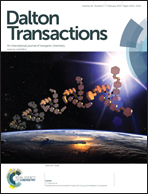Bi2Te(IO3)O5Cl: a novel polar iodate oxychloride exhibiting a second-order nonlinear optical response†
Abstract
The novel iodate oxychloride, Bi2Te(IO3)O5Cl, has been hydrothermally synthesized and structurally characterized. The compound crystallizes in the polar monoclinic space group Cc with a = 22.037(8) Å, b = 5.256(2) Å, c = 15.142(5) Å, and β = 104.499(7)°. Three types of asymmetric chromophore structural units, that is the electron lone-paired [IO3]− groups, the second-order Jahn-Teller effect (SOJT) [BiO6]9− units, and the distorted [TeO6]6− octahedra, coexist with cooperative dipole moment alignment along the c-axis direction of the crystal. This structure configuration gives the material a relatively large second harmonic generation (SHG) efficiency of approximately three times that of KDP for powder samples. Type I phase-matching at a wavelength of 1064 nm can be achieved as a result of the layered structure and large optical anisotropy of the crystal. First-principle density functional theory (DFT) calculations were performed to interpret relationships between the macroscopic optical properties and microscopic structures. The results indicate that the local dipole moments of the three types of chromophore units are simultaneously present in the compound with different contributions to the SHG effect. Additionally, thermal and optical properties of the compound were also characterized.


 Please wait while we load your content...
Please wait while we load your content...